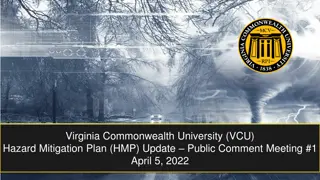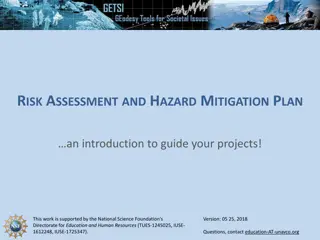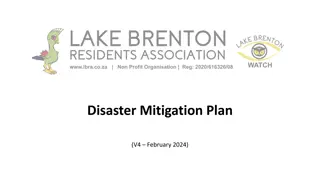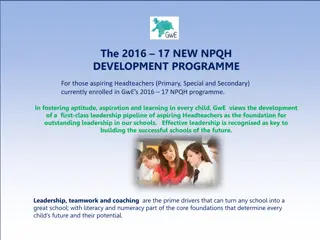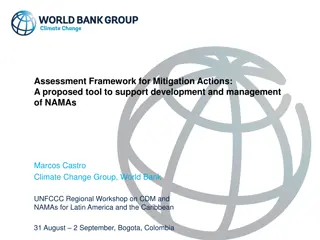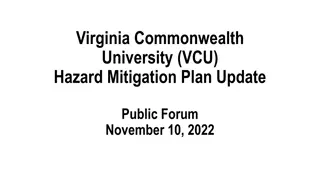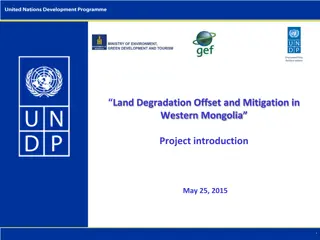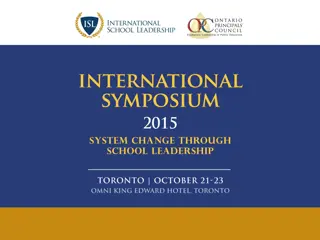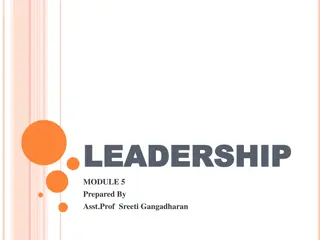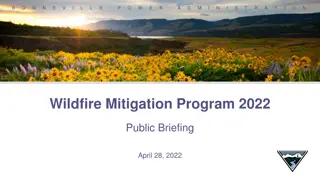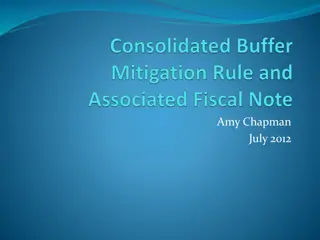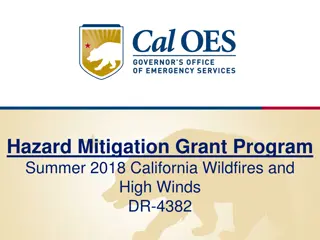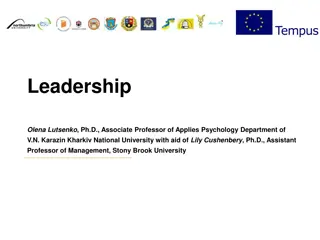Mitigation Framework Leadership Group Overview
The Mitigation Framework Leadership Group (MitFLG) plays a vital role in promoting and coordinating mitigation efforts across federal, state, local, tribal, and territorial governments, focusing on enhancing disaster resilience through awareness, coordination, and action. The group oversees the National Mitigation Framework and collaborates with various stakeholders to strengthen the nation's preparedness against disasters.
Download Presentation

Please find below an Image/Link to download the presentation.
The content on the website is provided AS IS for your information and personal use only. It may not be sold, licensed, or shared on other websites without obtaining consent from the author.If you encounter any issues during the download, it is possible that the publisher has removed the file from their server.
You are allowed to download the files provided on this website for personal or commercial use, subject to the condition that they are used lawfully. All files are the property of their respective owners.
The content on the website is provided AS IS for your information and personal use only. It may not be sold, licensed, or shared on other websites without obtaining consent from the author.
E N D
Presentation Transcript
Mitigation Framework Leadership Group (MitFLG) Briefing Deck Aly Briscoe, MitFLG Secretariat, FEMA Mitigation Framework Leadership Group
MitFLG Overview The Mitigation Framework Leadership Group (MitFLG) provides a coordinating structure for mitigation provides a coordinating structure for mitigation across the Federal government and with partners in mitigation nationally. The MitFLG operates according to the National Mitigation Framework (NMF), one of the five frameworks under Presidential Policy Directive 8 on National Preparedness and the National Preparedness Goal (NPG). The MitFLG s mission is to strengthen the nation s disaster resilience by expanding mitigation disaster resilience by expanding mitigation awareness, coordination, and action. awareness, coordination, and action. Mitigation is a cornerstone of a culture of preparedness against disasters. strengthen the nation s Figure 1: Mitigation Core Capabilities Mitigation Framework Leadership Group 2
MitFLG Responsibilities The MitFLG s areas of responsibility include the following: Promoting and facilitating the coordination of mitigation efforts across the federal government and with state, local, tribal, and territorial governments (SLTTs) and the private sector. Overseeing the maintenance and successful implementation of the NMF, the National Mitigation Investment Strategy, and the Mitigation Federal Interagency Operational Plan (FIOP). 01 01 04 04 Getting information about mitigation opportunities, programs, and benefits, into the hands of local decision-makers. Assessing the effectiveness of mitigation core capabilities as they are deployed nationally. 05 05 02 02 Coordinating interagency efforts to inform the annual National Preparedness Report. Coordinating policy recommendations on national-level issues. 06 06 03 03 Mitigation Framework Leadership Group 3
Composition of the MitFLG: Federal Partners Federal membership includes, but is not limited to: The MitFLG includes representatives from the federal government and state, local, tribal, and territorial (SLTT) governments. It is chaired by FEMA in consultation with Department of Homeland Security leadership. The current chair, by designation, is the Associate Administrator of the Federal Insurance and Mitigation Administration. Department of Agriculture Department of the Interior Department of Commerce Department of Labor Department of Transportation Department of Defense Department of Energy Department of the Treasury Department of Health and Human Services Environmental Protection Agency The MitFLG membership includes federal department and agency senior officials who can speak authoritatively on behalf of their respective government organizations. Department of Homeland Security General Services Administration Department of Housing and Urban Development Small Business Administration Mitigation Framework Leadership Group 4
Composition of the MitFLG: SLTT Partners Current non-federal representation includes: American Samoa Office of Disaster Assistance and Petroleum Management Tennessee Department of Environment & Conservation The MitFLG s SLTT representation is nominated by federal membership on staggered two-year terms to ensure that the MitFLG is informed of state, local, tribal, and territorial issues that affect the nation. Mille Lacs Band of Ojibwe Tribe of Indians Santa Clara Pueblo, Forestry Department New York State Department of State - Office of Planning, Development & Community Infrastructure USVI Territorial Emergency Management Agency Private industry coordination with the MitFLG occurs through coordinating structures, such as the Government and Sector Coordinating Councils (GCCs and SCCs), that have a mitigation-focused mission. Washington Metropolitan Transit Authority Mitigation Framework Leadership Group 5
CY22 MitFLG Priority Initiatives Equity Equity Climate Change Climate Change Align with executive orders and incorporate administration priorities across all implementation projects National Initiative to National Initiative to Advance Building Codes Advance Building Codes Recommendation 3.1 Encourage Communities to Adopt and Enforce Up-to-Date Building Codes Recommendation 2.3 Make Funding for Mitigation Investment Easier to Access Recommendation 3.3 Use and Expand Financial Products and Approaches to Reduce and Transfer Risk Mitigation Resource Mitigation Resource Portal Portal Place Place- -Based Based Technical Assistance Technical Assistance Recommendation 1.2 Increase Mitigation Investment by Building the Capacity of Communities to Address Their Risks Recommendation 1.3 Use Common Measures to Aid Decision-Making for Mitigation Investment Recommendation 2.2 Align Program Requirements and Incentives Joint FLG Joint FLG Collaboration Collaboration Mitigation Framework Leadership Group 6
National Mitigation Investment Strategy Oct 2022 Mitigation Framework Leadership Group
National Mitigation Investment Strategy The National Mitigation Investment Strategy provides a single, national strategy for advancing mitigation investment to reduce risks posed by natural hazard (i.e., floods, hurricanes, tornadoes, wildfires, and earthquakes) and increasing resilience to natural hazards. The MitFLG is responsible for guiding implementation of this strategy, which will involve the whole community. In order to support implementation, the MitFLG has created Task Forces In order to support implementation, the MitFLG has created Task Forcesto carry out specific initiatives as recommended in the Investment Strategy. Mitigation Framework Leadership Group 8
Investment Strategy Goals Show How Mitigation Investments Reduce Risk: Show How Mitigation Investments Reduce Risk: Objective: Provide stakeholders with a foundational understanding of how mitigation investment protects what they value. Goal 1 Coordinate Mitigation Investments to Reduce Risk: Coordinate Mitigation Investments to Reduce Risk: Objective: Foster better understanding of risks (quality risk data) to support investment decisions, assure alignment of programs and incentives toward risk reduction goals, and reduce complexity in access to investment funds. https://fema.zoomgov.com/j/1617608484 Goal 2 Make Mitigation Investment Standard Practice: Make Mitigation Investment Standard Practice: Objective: Assure that national stakeholders are participating in mitigation activities, especially decisions to enhance building codes and infrastructure (lifeline) standards and the use of financial products that link to mitigation (insurance, cat bonds, resilience bonds). Goal 3 Mitigation Framework Leadership Group
Goal 1 Show How Mitigation Investments Reduce Risk Recommendation 1.1 Make Mitigation Investments Relevant Recommendation 1.2 Increase Mitigation Investment by Building the Capacity of Communities to Address Their Risks Recommendation 1.3 Use Common Measures to Aid Decision-Making for Mitigation Investment Key:Climate Change Equity Mitigation Framework Leadership Group 10
Goal 2 Coordinate Mitigation Investments to Reduce Risk Recommendation 2.1 Make Risk Information More Available and Easier to Use Recommendation 2.2 Align Program Requirements and Incentives Recommendation 2.3 Make Funding for Mitigation Investment Easier to Access Key:Climate Change Equity Mitigation Framework Leadership Group 11
Goal 3 Make Mitigation Investment Standard Practice Recommendation 3.1 Encourage Communities to Adopt and Enforce Up-to-Date Building Codes Recommendation 3.2 Strengthen Critical Infrastructure and Lifelines Recommendation 3.3 Use and Expand Financial Products and Approaches to Reduce and Transfer Risk Key:Climate Change Equity Mitigation Framework Leadership Group 12
MitFLG Task Forces Oct 2022 Mitigation Framework Leadership Group
Building Codes Task Force Initiative Initiative Need Need Impact Impact Support the National Initiative to Advance Building Codes Increase alignment, efficiency, and effectiveness of federal programs Establish building code requirements for federal programs and policies Coordinate with FEMA Building Sciences division and other stakeholders to accomplish tasking directed by the Executive Office of the President Pursue concrete courses of action to close gaps in the federal approach to natural hazard mitigation Incentivize the adoption of building codes at the state and local level via federal investments, policies, and programs 14 Mitigation Framework Leadership Group
Place-Based Technical Assistance Task Force Initiative Initiative Need Need Impact Impact Use pilot project selection criteria based on lessons learned from the Wasatch Front URM Risk Reduction Strategy project Develop place-based processes, which can be replicated and applied across multiple levels, including state and local to address multi- objective risk reduction, long- term community resilience, and climate resilience that leads to implementable, equitable solutions. Provide high-quality and responsive technical assistance through interagency coordinated efforts to selected underserved and disadvantaged communities Identify how potential projects can showcase the value of coordinated place-based technical assistance Develop common tools, resources, and guidance for resilience technical assistance and capacity building across the federal government. 15 Mitigation Framework Leadership Group
Place-Based Technical Assistance Task Force Central Goal: Central Goal: Delivering resilience-focused technical assistance to underserved communities. Federal Agencies Public and Private Partners Resources Resilient communities Mitigation Framework Leadership Group 16
Thank you! Questions? Ask FEMA-MitFLG@fema.dhs.gov Mitigation Framework Leadership Group




